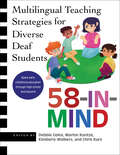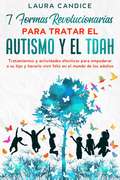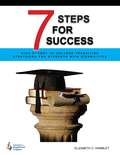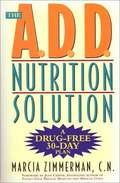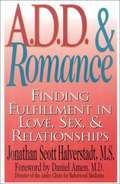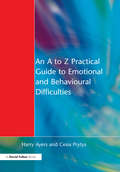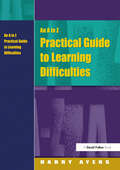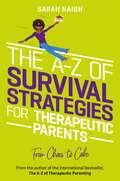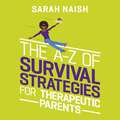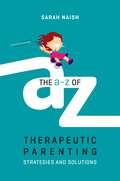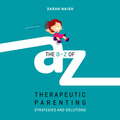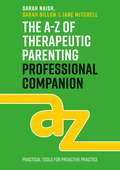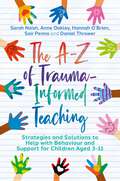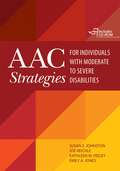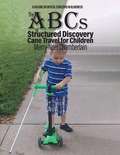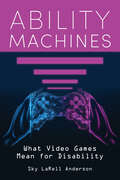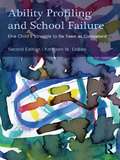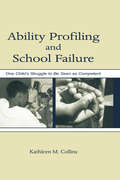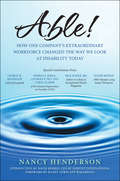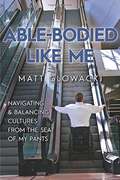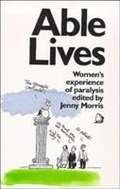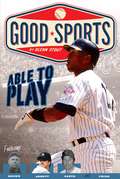- Table View
- List View
58-IN-MIND: Multilingual Teaching Strategies for Diverse Deaf Students
by Debbie Golos; Marlon Kuntze; Kimberly Wolbers; Chris KurzA highly practical and engaging resource for current and future teachers, 58-IN-MIND describes and demonstrates theoretically-driven, research-based, and classroom-tested best practices for using American Sign Language and English in instruction across the curriculum. The multilingual and multimodal instructional strategies presented here are embedded in approaches that aid learning and foster well-being. This book will support teachers in creating meaningful educational experiences for Deaf students in all grades, from early childhood education through high school. Each chapter is written by a team of researchers and P–12 teachers with at least one Deaf coauthor. With seventy-five percent of the authors being Deaf, this is the first teaching methods book to harness the expertise of Deaf professionals at this level, highlighting their vital role in Deaf education and in shaping inclusive and effective learning environments. This book meets the need for a resource that recognizes the diversity of Deaf students by creating space in the classroom to honor their home/heritage languages, cultures, races, genders, abilities, hearing levels, and other multiple and intersecting identities. Written in a conversational tone, the book includes core recommendations for instruction of the targeted subject area, examples of key strategies, lessons and real stories from those working in the field, suggestions for practice, and recommended resources. “58-IN-MIND” in the title refers to the version of the ASL sign "stick" that is made on the forehead, which is equivalent to the English idiom “to stick in one's mind.” As in, when students learn in a culturally responsive manner, the learning is likely to stick. The title also alludes indirectly to the collective aspirations of the chapter authors that the practices discussed in the book will also stick in the readers’ minds, and thus have a transformative impact on the way Deaf students are taught.
7 formas revolucionarias para tratar el Autismo y el TDAH: Tratamientos y actividades efectivos para empoderar a su hijo y hacerlo vivir feliz en el mundo
by Laura Candice¿Está buscando un programa de entrenamiento paso a paso para reiniciar su vida familiar y prosperar en un mundo pospandémico, siempre con una sonrisa? ¡Entonces, necesita este libro! ¿POR QUÉ ESTE LIBRO PUEDE AYUDARLE? En la vida, es difícil evitar el impulso conveniente e impetuoso de posponer las cosas y dejar de lado compromisos importantes. Es igualmente difícil evitar situaciones y sentimientos negativos dentro de la familia en estos días, en un mundo pospandémico. Pero si eso ha sido provocado por un constante sentimiento abrumador y por la creciente falta de tiempo, sus clientes están a punto de aprender a poner fin a todo eso para darle un giro a la vida, ¡para siempre! Este libro inteligente tiene un objetivo claro, que es enseñar la mentalidad y los hábitos correctos que debe adoptar en pasos muy simples para decir adiós a los pañales para siempre, construir y mantener una familia iluminada y hacer crecer niños felices sin pérdida de tiempo y dolores de cabeza. Este nuevo libro explicará: El método a prueba de balas para mantener a la familia feliz y siempre agradecida en un mundo pospandémico El programa estrenado [con ejercicios diarios] que ayudó a 1.457 padres a prosperar junto al TDAH y a vivir felices. Ejercicios paso a paso e instrucciones profesionales La forma inteligente de comprender el proceso educativo y ser un padre consciente
7 Steps For Success: High School to College Transition Strategies for Students with Disabilities
by Elizabeth HambletThis book gives students the proper preparation for college by empowering them to pursue success-- not just at college, but after graduation, too.
The A. D. D. Nutrition Solution: A Drug-Free Thirty-Day Plan
by Marcia ZimmermanThe first scientifically proven, effective, all-natural nutritional alternative to the much-prescribed drug Ritalin. Attention deficit disorder is a nutritional deficiency, not a psychological condition. This is the revolutionary discovery Marcia Zimmerman made during her ten years of research as a nutritional biochemist. That conclusion led her to develop a diet that addresses the specific needs of the 17 million adults and children suffering from ADD. Her easy-to-follow thirty-day plan has been proven just as effective as Ritalin in relieving the symptoms of ADD. Learn: - How women should boost their nutrition before conception to prevent ADD in their children. - Why boys are much likelier to be tagged as ADD than girls - How to get a reliable ADD diagnosis Reasons why parents prefer a diet plan to prescription drugs for ADD children - The effects of brain allergies on attention span - Foods to avoid that may exacerbate ADD - Fats and oils we all need to stay focused - Calming effects of carbohydrates - Concentration-enhancing protein - Why to stay away from simple sugars - The dangers of artificial food ingredients, and much more This important book will help us curb the epidemic growth of ADD in this country and change the way we treat those who have it now by addressing its source instead of merely treating its symptoms.
A.D.D. & Romance
by Jonathan Scott HalverstadtThis book examines what it is like to have ADD and be in a relationship.
An A to Z Practical Guide to Emotional and Behavioural Difficulties
by Harry Ayers Cesia PrytysThe aim of this practical and user-friendly A to Z handbook is to enable the interested reader to gain quick and easy access to entries relating to or associated with emotional and behavioral difficulties. It focuses on adult problems as well as those of children and adolescents. The entries clearly and succinctly define and explain emotional behavioral terms and some of the different ways in which emotional and behavioral problems can be approached or treated. Where appropriate, entries are accompanied by a brief bibliography. Useful addresses and contact phone numbers are also provided where appropriate. This guide is useful for all teachers, mentors, social workers, educational social workers, educational psychologists, counselors, care workers, students and other professionals and voluntary workers in allied fields. It will also be of interest to parents and carers.
An A to Z Practical Guide to Learning Difficulties
by Harry Ayers Francesca GrayAccessing up-to-date information about general and specific learning difficulties is made easy, with this indispensable reference book. Covering difficulties that relate to children, adolescents and adults, it includes: crucial legislation to keep practitioners 'in the know' useful addresses, telephone numbers and websites It also includes explanations of leaning difficulties including those less than well-known syndromes such as semantic pragmatic difficulties.
The A-Z of Survival Strategies for Therapeutic Parents: From Chaos to Cake (Therapeutic Parenting Books)
by Sarah Naish'This book is your hot flask of tea or coffee, and a cosy blanket which will keep you warm, safe and well on your journey, ensuring you reach the other side, mentally and physically well.'So, you want to help your child by therapeutic parenting, but how are YOU?This easy-to-follow, dip-in dip-out resource addresses common challenges and feelings experienced by therapeutic parents and offers 80 practical strategies to help you cope and survive. Bestselling parenting author Sarah Naish writes with humour and compassion, sharing her personal and professional experiences covering all of the essentials: self-maintenance, coping with isolation and rejection, scheduling holidays and, of course, the therapeutic importance of cake!Think you don't have the time or inclination for a bit of 'self-care'? This book will save time, save energy and help solve your problems - a 'must have' for all therapeutic parents.
The A-Z of Survival Strategies for Therapeutic Parents: From Chaos to Cake (Therapeutic Parenting Books)
by Sarah NaishAn A-Z of how to take care of YOU - survival strategies and solutions to common challenges faced by therapeutic parents.'This book is your hot flask of tea or coffee, and a cosy blanket which will keep you warm, safe and well on your journey, ensuring you reach the other side, mentally and physically well.'So, you want to help your child by therapeutic parenting, but how are YOU?This easy-to-follow, dip-in dip-out resource addresses common challenges and feelings experienced by therapeutic parents and offers 80 practical strategies to help you cope and survive. Bestselling parenting author Sarah Naish writes with humour and compassion, sharing her personal and professional experiences covering all of the essentials: self-maintenance, coping with isolation and rejection, scheduling holidays and, of course, the therapeutic importance of cake!Think you don't have the time or inclination for a bit of 'self-care'? This audiobook will save time, save energy and help solve your problems - a 'must have' for all therapeutic parents.(P) 2022 Jessica Kingsley Publishers
The A-Z of Therapeutic Parenting: Strategies and Solutions (Therapeutic Parenting Bks.)
by Sarah NaishTherapeutic parenting is a deeply nurturing parenting style, and is especially effective for children with attachment difficulties, or who experienced childhood trauma. This book provides everything you need to know in order to be able to effectively therapeutically parent. Providing a model of intervention, The A-Z of Therapeutic Parenting gives parents or caregivers an easy to follow process to use when responding to issues with their children. The following A-Z covers 60 common problems parents face, from acting aggressively to difficulties with sleep, with advice on what might trigger these issues, and how to respond. Easy to navigate and written in a straightforward style, this book is a 'must have' for all therapeutic parents.
The A-Z of Therapeutic Parenting: Strategies and Solutions (Therapeutic Parenting Books)
by Sarah NaishThe complete guide to therapeutic parenting, with an A-Z of applied advice for 60 common issuesTherapeutic parenting is a deeply nurturing parenting style, and is especially effective for children with attachment difficulties, or who experienced childhood trauma. This book provides everything you need to know in order to be able to effectively therapeutically parent.Providing a model of intervention, The A-Z of Therapeutic Parenting gives parents or caregivers an easy to follow process to use when responding to issues with their children. The following A-Z covers 60 common problems parents face, from acting aggressively to difficulties with sleep, with advice on what might trigger these issues, and how to respond.Easy to navigate and written in a straightforward style, this book is a 'must have' for all therapeutic parents.(P) 2019 Hodder & Stoughton Ltd
The A-Z of Therapeutic Parenting Professional Companion: Tools for Proactive Practice (Therapeutic Parenting Books)
by Sarah Naish Sarah Dillon Jane MitchellDesigned as a professional complement to Sarah Naish's bestselling A-Z of Therapeutic Parenting, this tried and tested resource offers practical tools for all professionals supporting therapeutic families.Based on the latest research, and with photocopiable worksheets, pro formas and charts to use with parents, these tools will help you to build supportive and stable relationships with families and reduce family breakdown.The resource is structured into three parts:1. The Trauma Tracker Tool - designed to support the stability of the family and to predict possible incidents by providing an understanding of the presenting behaviours in the context of the child's history2. The Developmental Foundation Planner - to help professionals to identify and address unmet developmental needs in a structured way as soon as a child is placed with a family and thereby help reduce instances of family breakdown3. The Behaviour - Assessment of Impact and Resolution Tool (BAIRT) - which enables practitioners of most levels to engage in a step by step intervention, breaking down the most complex behaviours with a problem solving supportive process, thereby reducing the effects of blocked care and enabling engagement with parents in an honest, positive process. Simple to use, and easy to implement, these tools will enable you to create therapeutic, trauma-informed assessments, intervention and support.
The A-Z of Trauma-Informed Teaching: Strategies and Solutions to Help with Behaviour and Support for Children Aged 3-11
by Sarah Naish Anne Oakley Hannah O'Brien Sair Penna Daniel Thrower"This is a remarkable achievement. Like Batman's Utility belt for teachers. So many practical, wise, inspiring, and achievable ideas are packed in here. I can imagine this becoming as indispensable for teachers as Gray's Anatomy is for doctors..." - Stephen Fry"If you want a book to assist with your work with traumatised children, choose this one. It is the best!" - Professor Peter Fonagy OBE, Chief Executive, Anna Freud National Centre for Children & Families"Humane and grounded in science, this book could change lives." - Sir Norman Lamb, Chair of Maudsley NHS and Children and Young People's Mental Health CoalitionWhat does trauma-informed teaching really look like in the classroom, and can we really achieve it?Maybe you, like many other teachers, will reach the end of a busy day feeling exhausted, deskilled and less than keen to dive into a book on the theory of trauma. Luckily you won't find any complex theory or jargon in this book, but you will gain an understanding of how small humans develop, how perplexing behaviours can be explained and learn inclusive strategies that will help all children in your classroom and school. Part 1 provides you with an explanation of what trauma-informed teaching involves. Then, Part 2 lists an A-Z of issues and behaviours for you to flip to in your busiest moments, ranging from Aggression and Lateness right through to Learning Challenges and Zzz (sleep issues). Gain new understanding into the children in your classroom with this book offering you strategies to better support every child's mental health and resilience.
AAC Strategies For Individuals With Moderate To Severe Disabilities
by Susan S. Johnston Joe Reichle Kathleen M. Feeley Emily A. JonesWith more children and young adults with severe disabilities in today's general education classsrooms, SLPs and other professionals must be ready to support their students' communication skills with effective AAC. They'll get the proven strategies they need with this intervention guide from top AAC experts, ideal for use as an in-service professional development resource or a highly practical text students will keep and use long after class is over. Essential for SLPs, OTs, PTs, educators, and other professionals in school settings, this book helps readers establish a beginning functional communicative repertoire for learners with severe disabilties. Professionals will start with an in-depth intervention framework, including a guide to AAC modes and technologies, variables to consider when selecting AAC, and how AAC research can be used to support practice. Then they'll get explicit, evidence-based instructional strategies they'll use to help children and young adults: initiate, maintain, and terminate an interaction; repair communication breakdowns; match graphic symbols to objects and events; request access to desired objects and activities; escape and avoid unwanted objects and activities; strengthen language comprehension and adaptive functioning; generalize communication skills across settings; and more. To help guide their interventions, professionals will get a CD-ROM with more than 35 forms on CD including: Checklist to Identify Potential Reinforcers; Intervention Planning Form; Performance Monitoring Forms; Task Analysis Development and Performance Monitoring Form; Checklist for Increasing Speed and Accuracy of Selection; and much more.
The Abacus Made Easy: A Simplified Manual for Teaching the Cranmer Abacus
by Mae E DavidowFrom the book: At Overbrook, [School for the Blind] Dr. Davidow was instrumental in establishing the use of the Cranmer Abacus as a part of the regular curriculum. Her enthusiasm for this pioneer method of teaching mathematics led others to adopt the use of the abacus. In her role as coordinating teacher, she worked with the members of the Mathematics Department and the results were highly successful. Hopeful that this success at Overbrook might be experienced by many teachers elsewhere, she was encouraged to write this manual. Her goal was to write a clear, simple manual which could be used by teachers or students. This book represents her achievement.
Abandoned: Now Stutter My Orphan
by Jerry HalvorsonAbandoned reveals the design and the outcome of the Monster Study in which orphans were made to stutter.
The ABCs of Structured Discovery Cane Travel for Children (Critical Concerns In Blindness)
by Merry-Noel ChamberlainStructured Discovery Cane Travel (SDCT) is an Orientation and Mobility (O&M) curriculum which focuses on the foundational techniques necessary to develop future independence for students who are blind or visually impaired. The ABCs of Structured Discovery Cane Travel for Children addresses essential non-visual concept development, techniques and mobility skills needed to travel efficiently, gracefully and safely within a myriad of natural environments while using the long, white cane with a metal tip as the primary mobility tool. This curriculum utilizes transformational knowledge and problem-solving opportunities through teachable moments to develop personal reflection and mental mapping which can be utilized post instruction. These students maximize their cognitive intrinsic feedback while completing everyday mobility tasks. Parents and instructors of children who are blind or visually impaired will comprehend the essentials of SDCT by reading The ABCs of Structured Discovery Cane Travel for Children; in addition, they will receive a treasure trove of O&M skill-building activities.
Ability Machines: What Video Games Mean for Disability (Digital Game Studies)
by Sky LaRell AndersonVideo games are both physically and cognitively demanding—so what does that mean for those with a disability or mental illness? Though they may seem at odds, Ability Machines illuminates just how vital video games are to understanding our bodies and abilities.In Ability Machines, Sky LaRell Anderson shows us how video games can help us imagine what our abilities mean and how they engage us physically, behaviorally, and cognitively to envision our agency beyond limitations. On the surface, this can mean games provide power fantasies; more profoundly, games can fundamentally reshape cultural and personal understandings of mental health, illness, disability, and accessibility. Video games are indeed ability machines that produce a reimagined state of agency. Featuring a comparative analysis of key video game titles, including Metal Gear Solid V, Wolfenstein II, Celeste, Devil May Cry 5, Hellblade: Senua's Sacrifice, Hades, Nier: Automata, and more, Ability Machines tackles larger questions of ability and how our bodies relate to interactive media.
Ability Profiling and School Failure: One Child's Struggle to be Seen as Competent
by Kathleen M. CollinsAbility Profiling and School Failure, Second Edition explores the social and contextual forces that shape the appearance of academic ability and disability and how these forces influence the perception of academic underachievement of minority students. At the book’s core is the powerful case study of a competent fifth grader named Jay, an African American boy growing up in a predominantly white, rural community, who was excluded from participating in science and literacy discourses within his classroom community. In this new edition, researcher and teacher-educator Kathleen Collins situates the story of Jay’s struggle to be seen as competent within current scholarly conversations about the contextualized nature of dis/ability. In particular, she connects her work to recent research into the overrepresentation of minority students in special education, exploring the roles of situated literacies, classroom interactions, and social stereotypes in determining how some students come to be identified as "disabled." Ability Profiling and School Failure, Second Edition comprises a thorough investigation into the socially constructed nature of ability, identity, and achievement, illustrating the role of educational and social exclusion in positioning students within particular identities.
Ability Profiling and School Failure: One Child's Struggle to Be Seen As Competent
by Kathleen M. Collins Kathleen M CollinsAbility Profiling and School Failure: One Child's Struggle to Be Seen as Competent explores the social and contextual forces that shape the appearance of academic ability and disability and how these forces influence the perception of academic underachievement of minority students. It is a powerful case study of a competent fifth grader, an African American boy growing up in a predominantly white, rural community, who was excluded from participating in science and literacy discourses within his classroom community. The case study form allows for the integration of the story of the student's struggle to be seen as competent in school, a context where his teacher perceives him as learning disabled, with Collins' own perspective as a researcher and teacher-educator engaged in a professional development effort with the teacher. The contribution of this book is to make visible the situated and socially constructed nature of ability, identity, and achievement, and to illustrate the role of educational and social exclusion in positioning students within particular identities. Highly relevant across the field of education, this book will particularly interest researchers, graduate students, and professionals in literacy and science education, curriculum and instruction, sociocultural theories of learning, discourse analysis of classrooms, research on teaching and learning, special education, social foundations, and teacher education.
Ability Structure and Loss of Vision
by Jyrki JuurmaaPsychological testing of the ability structures of the blind and sighted was commenced almost simultaneously during the first decades of this century. However, a majority of the studies concerning the blind, and the most crucial among them, sought to develop IQ-type test batteries, intended mainly for appraising their school achievement. By contrast, systematic studies have not been carried out to explore the relationships among different, mutually relatively independent traits and the quantitative contributions of such traits to different test performances. This lack of interest is perhaps due to the narrow range of occupations regarded as suitable for the blind: there has been no acute need for a more differentiated picture.
Able!: How One Company's Extraordinary Workforce Changed the Way We Look at Disability Today
by Nancy HendersonIn a time when companies are outsourcing abroad, Habitat International, a Tennessee-based carpet manufacturer, has managed to achieve superior levels of productivity at home, often two to three times greater than its competition. Habitat's business has grown enormously, with much of its new business coming from work outsourced to them by competitors who could not come close to matching its productivity.Habitat's secret: they hire the people no one else will.At Habitat three of every four workers have a physical or mental disability. They earn normal wages and are cross-trained on every job. They work harder, with less supervision, lower turnover and an unparalleled level of loyalty. The challenges have been significant; the rewards extraordinary.This is Habitat's story. It's a powerful and moving tale of personal courage, deep commitment and challenging expectations. It's a story of success and personal triumph. It'll change the way you think about business … and the people around you.
Able-bodied Like Me: Navigating And Balancing Cultures From The Seat Of My Pants
by Matt GlowackiIn his insightful new memoir, Able-Bodied like Me, Matt Glowacki, civility speaker and author, chronicles the changing attitudes in our society—and in himself—about what it means to be disabled. <P><P>In the 1970s, when Glowacki was born, disabilities were still considered something to hide. Despite being born without legs, Glowacki pushed back against this narrative. He didn’t consider himself disabled and thought the term imposed unneeded limitations. He also balked at the tone-deaf remarks of others. He didn’t want to be an “inspiration” to people without impairments or a convenient way for others to signal their own virtue. Glowacki wanted to simply live his life, and he clearly explains how harmful certain remarks and actions can be for people in the disabled community. <P><P>In his memoir, Glowacki lists eighteen points to ponder as you reflect on your own assumptions and actions. Glowacki also examines his own changing beliefs about the term “disability,” as well as society’s shifting perspective. <P><P>As Glowacki shares the challenges he and others face in their everyday lives, he also offers suggestions about how to foster an environment of mutual respect and understanding. Glowacki certainly doesn’t want your pity. He just wants you to listen.
Able Lives: Women's Experience of Paralysis
by Jenny MorrisThis is a book written by spinal cord injured women who want to share their experiences with newly injured women and their friends and relatives, and to impress our concerns upon the general public and professionals. It is part of a growing movement to bring disability issues which previously have been kept private - behind the closed doors of individual lives - out into the open. We hope there will be many more books like this one to follow.
Able to Play: Overcoming Physical Challenges (Good Sports)
by Glenn StoutAble to Play shares the inspiring stories of four baseball players. Mordecai "Three Finger"Brown, Ron Santo, Jim Abbott, and Curtis Pride faced physical challenges other players didn't have. With determination and guts, they didn't just overcome; they excelled. This book is a game-changing celebration of overcoming odds.
